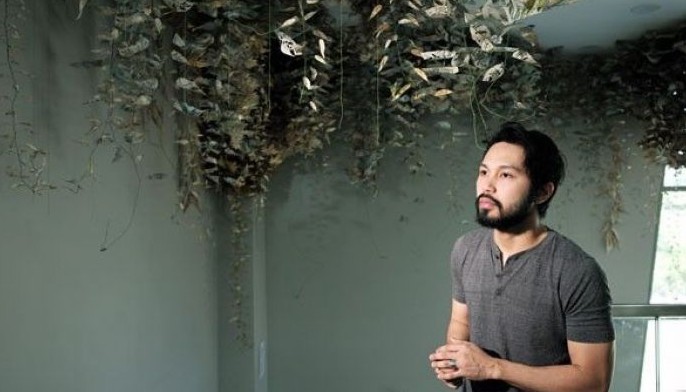MANILA, Philippines — When Ryan Villamael showed his paper cutouts in his first solo exhibition, he thought it would be his last. The initial response of the audience was one of befuddlement. Cutouts are usually relegated to handicraft or child’s play. But Villamael’s intervention into the fragile medium entailed not just cutting but concept. By contemplating paper as a fraught site (after all, it is also the medium of books, maps, and other archival materials), Villamael liberated the material to become an arbiter of meaning, one that traffics in the intersection of self and society, of biography and geography.
Now, Villamael is considered as the foremost practitioner in the medium, coming up with eloquent paper sculptures and installations that investigate the nature of borders, the tactile representations of history, the decay of civilizations. Paper becomes a “paradise lost,” an overgrowth of leaves, an eloquent latticework of remnant cartography. In the case of “Behold A City,” Villamael’s special exhibition at Art Fair Philippines, paper becomes the topography of a city.
“Behold a City” was first showcased at Silverlens Gallery in 2015, after Villamael’s fresh win of all the three international residencies of Ateneo Art Awards. The city alluded to in the title was Manila. Home to almost two million souls and a complex nexus of heritage, modernity, and all sorts of compulsions — political or otherwise — that seek to define it, Manila is as much an idea as it is a place. The locus and inspiration of the current work remains centered in the capital, but this is not Manila whittled down to a scale model; rather, a re-imagination of the city.
Villamael’s choice of Manila as subject matter comes from something deeply personal. Back in college, he would buy his art materials in Quiapo and check out its landmarks. “That’s when I realized Manila is beautiful,” he says. “When I learned the history of how it was built, how it was founded, what were its struggles, what were its triumphs, I felt, ‘What a waste.’ I needed to do something — how to express it, how to elevate it, how to celebrate it. I guess it’s the work.”
Just like in the earlier iteration, the installation features cutouts of structures and edifices that adorn — or used to adorn — its charming streets and world-famous boulevards. For the silhouettes of these architectural gems, Villamael consulted historical books and archives published during the American Occupation. He pored over old photographs of the city, essentially how things were before World War II that led to the carpet bombing of Manila, which made it the most devastated city in the world after Warsaw.
The initial cutouts were lost to a fire (an eerie mirroring of the destruction of the city), which means that Villamael has to “rebuild” the city. Villamael clarifies that the second version is not a replica of the first but simply an extension of the concept, where the “originality” of the work resides. The opportunity to recreate the work from scratch, however, has allowed Villamael “to be more specific to what I wanted to include” and “to focus more on the details of the work.”
“Behold a City” for the Art Fair features an entirely new arrangement. As a commentary on dubious beautification projects (such as slapping the façades of turn-of-the-century buildings with a garish coat of paint), one side of cutouts is covered by the kitschy mantel that covers the tables of road-side restaurants (carinderia). “I think that’s what’s lacking, the long-term intention of where we want to bring out country,” Villamael says. “I think we had it before.”
Part of the installation is the play of light and shadow that expands and repeats the work. Spotlights are trained on the cutout buildings, which project their shadows on the wall. The negative image mirrors the architectural forms, this time larger and more looming, as if underscoring how they are no longer accessible, consigned forever to the shadowy past. The viewers, whom Villamael encourages to interact with the work, will also be part of the installation as shadows on the wall, as if they are navigating a version of Manila that is a pure invention of the artist.
Villamael laments the current state of the capital. “There is a certain tiredness to the city,” he states. “It always tries to revive itself, then fails, then tries again. I don’t want to be nostalgic or emotional, but it seems that the city wants to offer something to you, but it doesn’t know how.” “Behold a City” is Villamael’s way of keeping the residual glory of the Manila alive, his love letter to the city of his private reckoning: “This is how I see you, these are my hopes and dreams for you.”


